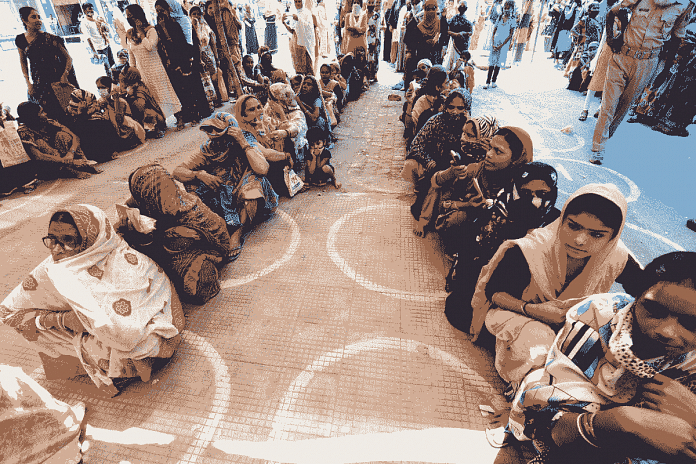New Delhi: The Modi government’s Jan Dhan Yojana may have paved way for more women to own bank accounts but a study shows that a vast majority have little or no authority over money and continue to rely on their spouse’s income.
In August last year on the completion of eight years of the Pradhan Mantri Jan Dhan Yojana, Union finance minister Nirmala Sitharaman said that over 56 per cent of the country’s then 46 crore Jan Dhan account holders are women.
However, a published report of US-based Women’s World Banking, a not for profit organisation, shows that two-thirds of the 1,150 women Jan Dhan account surveyed in Uttar Pradesh and Bihar depended on their husband’s income.
The study, called ‘Powering India’s Heartlands Through Jan Dhan Plus’, was published on the basis of a survey conducted in Shahjahanpur district in UP and Muzaffarpur and Gaya districts in Bihar, and was conducted with the help of the Bank of Baroda.
“Most of the women who responded are married and live with their husbands. They identify their husband’s earnings as the main source of income. Only a small number of women said that they contribute significantly to their household income,” the report said.
The study also found women’s savings were often underreported, especially given that these were not made through the official banking system. Many women also admitted that it was a challenge to save money, it said.
The report suggested that not only the lack of a regular income but also the lack of agency over household money and societal norms were barriers to women making any meaningful savings.
Also Read: Is WFH solution to India’s low female labour participation? Not really, says economist
Money that’s not hers
According to the report, one of the reasons why a vast majority of the women depend on their spouse’s income was the absence of decision-making on agricultural income.
“Agriculture is an important part of women’s livelihood in rural India, but women are conservative in articulating their contribution to agricultural activities,” it said.
This, according to the report, could also be because many women in rural India are not gainfully employed — meaning that they don’t earn an income from economic activities.
According to the survey, about 63.8 per cent of women reported that they were fully engaged in household chores. Another 6.2 per cent were engaged in household farms, either part or full-time, and 8 per cent of women took up irregular seasonal jobs.
According to the report, only 5.2 per cent of women in rural India said that they were working either full or part-time for a regular salary.
These factors undermine the extent to which women can save, the report suggests, with almost 50 per cent of women saying that they never saved.
“Lack of their own income and limited decision-making power in the household restrict women’s savings habit. Rural women in these regions have limited decision-making power over the household’s agricultural income, even when the women are directly engaged in their household’s farming activities,” the report said.
Even those who did manage to save did not actually deposit the money in their bank accounts — the survey showed that 41 per cent of women were still saving their money in cash at home.
“Dhan accounts in rural India practice saving, but not always in their bank accounts. They adopt different savings methods,” the report said. “Women are, therefore, using small savings to build resilience against sudden shocks like health, death, or climate change-related weather events.”
What can be done
Despite these drawbacks, however, experts that ThePrint spoke to believe that the Jan Dhan Yojana has helped women enter the formal banking system.
Lekha Chakraborty, a professor at the National Institute of Public Finance and Policy, believes that the problem cannot be fully resolved even if the number of women entering the formal workforce goes up. A lot, she says, depends on “gender differentials in the intrahousehold bargaining power”.
“Women may earn more if their Labour Force Participation Rate (LFPR) goes up. However, the control over their earned income and propensity to save is determined by the power relations within the household,” she told ThePrint. “Financial autonomy though LFPR and financial inclusion are directly related only if women can navigate intrahousehold power relations, or it is often determined by what we often refer to as women’s ‘agency’.”
Women’s financial inclusion specialist Kalpana Ajayan, who is the Regional Head of South Asia for Women’s World Banking, disagrees with the notion that women are not gainfully employed in economic activities.
“Rural women actively contribute to family and household incomes by working on the farm (through sowing, harvesting, processing, etc.), or non-farm (such as cattle care) activities, or in one or more aspects of household businesses, such as a kirana store or flour mill. But since they don’t necessarily earn a salary from it, it’s not recognised as employment. Even childcare and elderly care are most often the responsibilities of the woman, over and above household chores, for which she doesn’t receive any income,” she told ThePrint.
Women working on household farms don’t often consider themselves as contributing to the household income, she added.
Kalpana also recommends changes at the policy level. The government, she says, must invest in collecting and creating gender-aggregated data, “which can reflect women’s participation in agricultural, non-agricultural, and other economic activities that will rightfully highlight their contribution”.
“This data can be further matched with banking and finance metrics, which will help financial sector policies and policymakers design gender-intentional products and services,” she said.
This article has been updated with the correct descriptor for not for profit organisation Women’s World Banking. The error is regretted.
(Edited by Uttara Ramaswamy)
Also Read: What reports on Indian women’s falling participation in labour force don’t tell you






